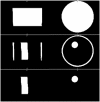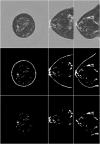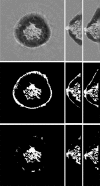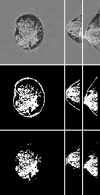Quantitative assessment of breast density using transmission ultrasound tomography
- PMID: 30893476
- PMCID: PMC6618090
- DOI: 10.1002/mp.13503
Quantitative assessment of breast density using transmission ultrasound tomography
Abstract
Purpose: Breast density is important in the evaluation of breast cancer risk. At present, breast density is evaluated using two-dimensional projections from mammography with or without tomosynthesis using either (a) subjective assessment or (b) a computer-aided approach. The purpose of this work is twofold: (a) to establish an algorithm for quantitative assessment of breast density using quantitative three-dimensional transmission ultrasound imaging; and (b) to determine how these quantitative assessments compare with both subjective and objective mammographic assessments of breast density.
Methods: We described and verified a threshold-based segmentation algorithm to give a quantitative breast density (QBD) on ultrasound tomography images of phantoms of known geometric forms. We also used the algorithm and transmission ultrasound tomography to quantitatively determine breast density by separating fibroglandular tissue from fat and skin, based on imaged, quantitative tissue characteristics, and compared the quantitative tomography segmentation results with subjective and objective mammographic assessments.
Results: Quantitative breast density (QBD) measured in phantoms demonstrates high quantitative accuracy with respect to geometric volumes with average difference of less than 0.1% of the total phantom volumes. There is a strong correlation between QBD and both subjective mammographic assessments of Breast Imaging - Reporting and Data System (BI-RADS) breast composition categories and Volpara density scores - the Spearman correlation coefficients for the two comparisons were calculated to be 0.90 (95% CI: 0.71-0.96) and 0.96 (95% CI: 0.92-0.98), respectively.
Conclusions: The calculation of breast density using ultrasound tomography and the described segmentation algorithm is quantitatively accurate in phantoms and highly correlated with both subjective and Food and Drug Administration (FDA)-cleared objective assessments of breast density.
Keywords: breast density; image segmentation; medical imaging; transmission ultrasound; ultrasound tomography.
© 2019 The Authors. Medical Physics published by Wiley Periodicals, Inc. on behalf of American Association of Physicists in Medicine.
Conflict of interest statement
All authors are employees of QT Ultrasound, LLC.
Figures















Similar articles
-
Volumetric breast density evaluation from ultrasound tomography images.Med Phys. 2008 Sep;35(9):3988-97. doi: 10.1118/1.2964092. Med Phys. 2008. PMID: 18841850
-
Novel approach to evaluating breast density utilizing ultrasound tomography.Med Phys. 2007 Feb;34(2):744-53. doi: 10.1118/1.2428408. Med Phys. 2007. PMID: 17388192
-
Fatty and fibroglandular tissue volumes in the breasts of women 20-83 years old: comparison of X-ray mammography and computer-assisted MR imaging.AJR Am J Roentgenol. 1997 Feb;168(2):501-6. doi: 10.2214/ajr.168.2.9016235. AJR Am J Roentgenol. 1997. PMID: 9016235
-
Quantitative Assessment of Breast Density: Transmission Ultrasound is Comparable to Mammography with Tomosynthesis.Cancer Prev Res (Phila). 2019 Dec;12(12):871-876. doi: 10.1158/1940-6207.CAPR-19-0268. Epub 2019 Oct 23. Cancer Prev Res (Phila). 2019. PMID: 31645343
-
Breast Cancer Risk and Mammographic Density Assessed with Semiautomated and Fully Automated Methods and BI-RADS.Radiology. 2017 Feb;282(2):348-355. doi: 10.1148/radiol.2016152062. Epub 2016 Sep 5. Radiology. 2017. PMID: 27598536 Free PMC article.
Cited by
-
Investigating the Use of Traveltime and Reflection Tomography for Deep Learning-Based Sound-Speed Estimation in Ultrasound Computed Tomography.IEEE Trans Ultrason Ferroelectr Freq Control. 2024 Nov;71(11):1358-1376. doi: 10.1109/TUFFC.2024.3459391. Epub 2024 Nov 27. IEEE Trans Ultrason Ferroelectr Freq Control. 2024. PMID: 39264782 Free PMC article.
-
Low frequency 3D transmission ultrasound tomography: technical details and clinical implications.Z Med Phys. 2023 Aug;33(3):427-443. doi: 10.1016/j.zemedi.2023.04.006. Epub 2023 Jun 7. Z Med Phys. 2023. PMID: 37295982 Free PMC article.
-
A review of ultrasound monitoring applications in agriculture.Front Plant Sci. 2025 Jul 7;16:1620868. doi: 10.3389/fpls.2025.1620868. eCollection 2025. Front Plant Sci. 2025. PMID: 40692673 Free PMC article. Review.
-
A Forward Model Incorporating Elevation-Focused Transducer Properties for 3-D Full-Waveform Inversion in Ultrasound Computed Tomography.IEEE Trans Ultrason Ferroelectr Freq Control. 2023 Oct;70(10):1339-1354. doi: 10.1109/TUFFC.2023.3313549. Epub 2023 Oct 17. IEEE Trans Ultrason Ferroelectr Freq Control. 2023. PMID: 37682648 Free PMC article.
-
The Potential Role of the Fat-Glandular Interface (FGI) in Breast Carcinogenesis: Results from an Ultrasound Tomography (UST) Study.J Clin Med. 2021 Nov 29;10(23):5615. doi: 10.3390/jcm10235615. J Clin Med. 2021. PMID: 34884317 Free PMC article.
References
-
- Harvey JA, Bovbjerg VE. Quantitative assessment of mammographic breast density: relationship with breast cancer risk. Radiology. 2004;230:29–41. - PubMed
-
- Boyd NF, Lockwood GA, Byng JW, Tritchler DL, Yaffe MJ. Mammographic densities and breast cancer risk. Cancer Epidemiol Biomark Prev. 1998;7:1133–1144. - PubMed
MeSH terms
Grants and funding
LinkOut - more resources
Full Text Sources
Molecular Biology Databases

